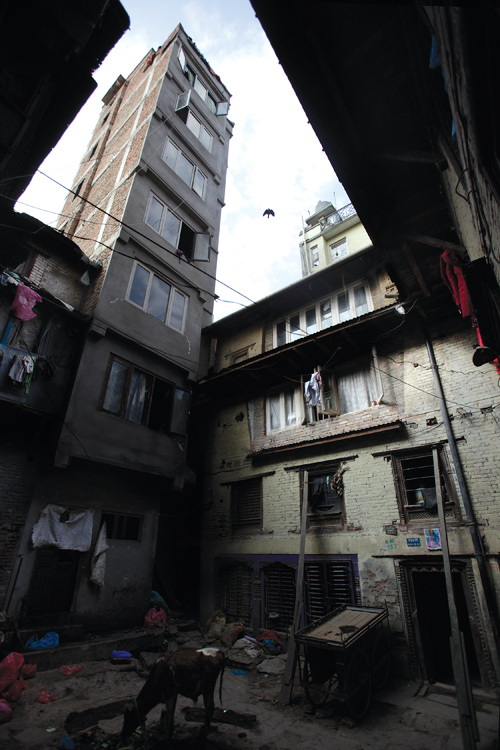Lessons still not learnt

Photos: BIKRAM RAI/NEPALI TIMES
Earthquakes are inevitable in Nepal. It is not a question of ‘if’, but ‘when’. And ‘when’ was 2:28PM on 15 January 1934. It was 11:56AM on 25 April, 2015. Another memorable and tragic date in future is certain.
But Nepalis have short memories. As long as aftershocks shook us, we were reminded about the horrors. But seven years after 2015, the fear has evaporated.
This is not panic-mongering, or crying wolf. It is reality: every part of the central Himalaya is hit by a megaquake above 8 magnitude every 500 years or so, and a moderate intensity quake every 100 years.
The 2015 disaster was not a Big One, 1934 was. Nonetheless, both released some of the built-up tectonic tension underneath us. What worries Himalayan seismologists is that there has been no major earthquake in western Nepal in the last 500 years. The rock strata beneath are stretched to breaking point.
Experts tell us that if an 8M earthquake strikes in this seismic gap between Pokhara and Dadeldhura, it will also rock Kathmandu and be even more damaging than 2015.
That 7.8M earthquake seven years ago was comparable to the 7.7M quake in Gujarat in 2001, and the 7.6M temblor in 2005 in Kashmir. In 2015, Nepal saw greater physical damage, but India and Pakistan had much higher casualties. One reason was that we were lucky 25 April 2015 was a Saturday, and students were not in classrooms.
To mark National Earthquake Safety Day on 15 January, we recap the past seven years. There is some good news: over 80% of reconstruction is complete. Nepal’s recovery has been smoother than other developing countries hit by mega disasters.
Despite initial delays due to political muddles and the Blockade, reconstruction in most sectors picked up in 2016. Today, only health facilities and heritage sites are lagging at about 65% completion. Most rebuilt homes follow national seismic resistance guidelines because masons were trained, and there was monitoring before grants were released in installments.
However, reconstruction in Kathmandu and other towns have not even passed the 60% mark, and could take another five years. The Rs300,000 reconstruction grant was just not enough for families to rebuild urban homes. More worrisome is that whatever has been rebuilt in Kathmandu Valley mostly flout building codes and permits.
The Gongabu neighbourhood saw 160 deaths in 2015, most of them were crushed under illegally built concrete structures. Most of those high rises have been rebuilt using the same faulty techniques.
Except in Gongabu, most concrete structures survived the 2015 quake in Kathmandu. This has reinforced public misconception that cement houses, regardless of how they are built, are stronger than brick and mortar ones.
However, seismologists say that if the tremors in 2015 were only a few seconds longer and the magnitude slightly higher, many of Kathmandu’s concrete buildings would have also collapsed. They are unlikely to be spared in the next big one.
Seven years after the earthquake, it is back to business as usual. In fact, Kathmandu is now more dangerous because it is even more densely packed, and there are more multi-storey blocks. Clearly, awareness about earthquakes has not translated into safer construction — we have forgotten that earthquakes do not kill people, poorly built structures do.
Surya Narayan Shrestha at the National Society for Earthquake Technology – Nepal (NSET) tells us that building codes need to be strictly enforced with stringent monitoring mechanisms. Municipalities must be stricter with building permits.
Next, masons and concrete moulding workers need skills upgrading in earthquake resistant building technology. Security personnel now need training in search and rescue under collapsed concrete structures.
Shrestha says schools, hospitals and public buildings need to be retrofitted urgently. Many schools NSET had helped retrofit withstood the 2015 earthquake, and this model needs to be replicated across western Nepal.
Nepal’s towns are losing open spaces, which are vital as shelters in the aftermath of future earthquakes. Kathmandu must protect remaining open spaces, and these efforts need to be scaled up not just for earthquake safety but also to restore the city’s lungs.
Preparedness will mean life or death for all Nepalis, not just for those in the seismic gap in the western part of the country. This should be the main message on the National Earthquake Safety Day.
Earthquakes are beyond our control, but we can make ourselves safer when they happen.
Sonia Awale
writer
Sonia Awale is Executive Editor of Nepali Times where she also serves as the health, science and environment correspondent. She has extensively covered the climate crisis, disaster preparedness, development and public health -- looking at their political and economic interlinkages. Sonia is a graduate of public health, and has a master’s degree in journalism from the University of Hong Kong.
